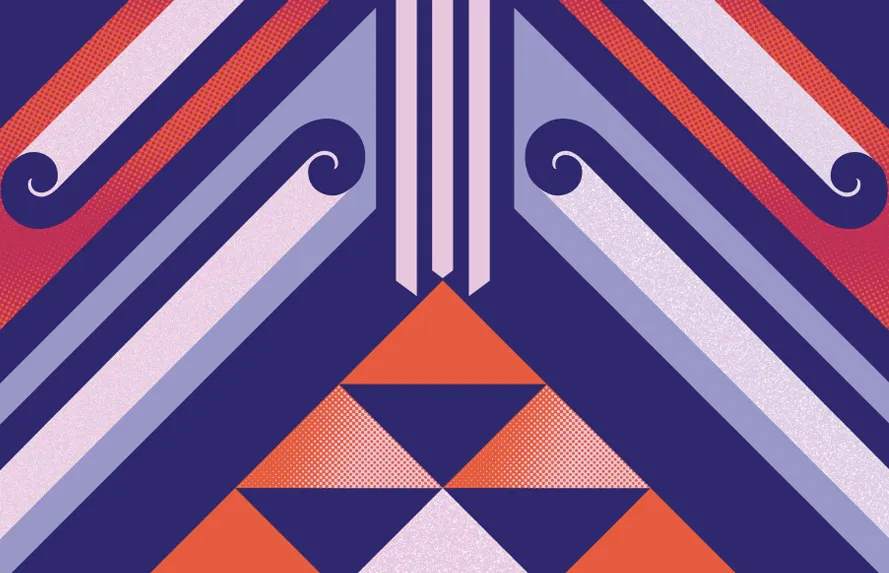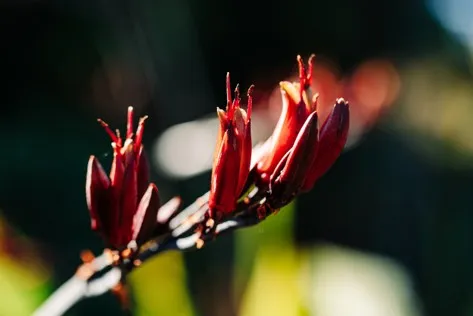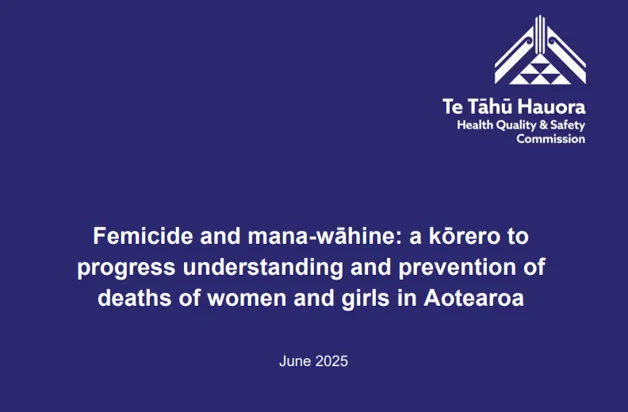New report: Femicide: Deaths resulting from gender-based violence in Aotearoa New Zealand
10
July
2025


Femicide: Deaths resulting from gender-based violence in Aotearoa New Zealand
‘Femicide: Deaths resulting from gender-based violence in Aotearoa New Zealand | Kōhuru Wahine: nā te ririhau ā-ira i te whenua o Aotearoa’ has been released. The report was produced by family violence death review subject matter experts (FVDR SMEs) on behalf of He Mutunga Kore | National Mortality Review Committee.
The report explores the definition of femicide, a term first coined in the USA and Latin American countries to describe the murders of women by men, motivated by hatred, contempt, pleasure or a sense of ownership of women. Including the expression ‘gender-based violence against women’ in their definition of femicide, CEDAW’s General Recommendation 35 emphasises that this form of violence should be understood ‘as a social rather than an individual problem’ (p. 21).
In an Aotearoa context, this report considers femicide as the most extreme manifestation of gender-based violence against woman and girls. It explores deaths beyond those that occur within the family, which can be intimate or non-intimate, ranging from interpersonal to systemic violence (p. 22). Femicide is a human rights violation.
In addition to intimate partner homicide (IPV) deaths of women, the report examines deaths associated with damage to women’s bodies, including suicide of women, girls, pregnant women and women who have recently given birth; violent deaths of unborn babies; and non-IPV homicide of women, especially older women. It also considers how technology-facilitated abuse, human trafficking and organised crime contributes to femicide, and the particular impacts of femicide on wāhine and kōtiro Māori (Māori women and girls).
Dr Nicola Atwool, chair of the FVDR SME group, said that using the term “femicide” shifts the focus from a simplistic framing of violence as individual incidents to a human rights issue the state has a duty to address.
“Individualistic responses don’t address the underlying issues embedded in continued gender inequity… This has limited our capacity to recognise links between violence and outcomes like suicide, perinatal and elder deaths. Only by seeing the bigger picture can we grasp the true damage.”
Key findings:
Police data cited in the report indicates that women and girls account for slightly over one-third of homicide victims in Aotearoa. 58% of these deaths are caused by family members. The other 42% of deaths are not routinely captured in the FVDR data set and there is insufficient evidence to determine if they were also victims of femicide.
The report highlights that mothers who die by suicide are substantially over-represented in data on police-reported violence experience. It is also likely some of those who were not represented in police data had also experienced violence, but did not report it.
There were also strong links between maternal suicide deaths and drugs and alcohol abuse, as well as a lack of maternal support services after birth or after the loss of a baby. Similarly, violence during pregnancy is a threat to life both for the pregnant woman and the baby; perinatal deaths associated with violence increased over the 2020-2022 period compared with 2018-2019.
Alison Eddy, Chief Executive of the New Zealand College of Midwives, said:
“This report confirms what midwives see every day. Pregnancy can be a time of vulnerability for many women. Midwives are in a unique position to notice the warning signs and refer for help, but we need to ensure appropriate services are immediately available and adequately resourced to support those referrals.
“The connections midwives build with women and whānau can be powerful. We must ensure our midwifery workforce is equitably equipped and that culturally safe, community-based supports are available country-wide —particularly for wāhine Māori, who are disproportionately impacted.
“This is not only a health system issue, it’s about human rights and equity. We must honour the lives lost by acting now to create a more connected, culturally responsive, and preventive approach.”
The report notes significant gaps in the data available for determining rates or trends in femicide, especially concerning migrant/refugee status, disability, sexual orientation and gender identity. There is also a lack of information on the association between organised crime, human trafficking, and femicide in Aotearoa, limiting our ability to take preventative action. Disability and chronic health conditions place older women at increased risk of homicide and are often reported inaccurately in the media.
The report emphasises that Aotearoa must do more to address femicide to make all women, including those who are transgender or gender diverse, safe and more visible in society.
Inequitable experiences for wāhine and kōtiro Māori
The report identifies ongoing inequities in the experience of violence for Māori women and girls, highlighting the need for distinct approaches for Māori and non-Māori.
“We identified inequities in the rates of family violence homicide for wāhine and kōtiro Māori compared with non-Māori women and girls between 2018 and 2022. Had these inequities not existed, there would be approximately 25 more wāhine and kōtiro Māori alive today.”
During the development of the report, stakeholders stressed the need to address gender-based violence against wāhine Māori as a whole-of-life issue (p. 34-35). Inadequate, inappropriate, or otherwise harmful responses provided in the past have reduced Māori trust in government agency service providers and enhanced vulnerability to ongoing violence victimisation (p.69). This is particularly true of the over-representation of tamariki Māori in care, abuse experienced in care, limited access to maternal and mental health services, and the intersecting burdens of racism, colonisation, and gender-based violence.
Overall recommendations
The report makes two sets of recommendations.
The first are the concluding observations from the 9th Periodic Review of Aotearoa New Zealand’s progress under the Committee on the Elimination of Discrimination Against Women (CEDAW) (Box 5, p.66).
The second are recommendations from engagement with National Mortality Review Committee stakeholders. These recommendations include:
- Implement effective and comprehensive support for survivors of femicide and FV homicide and those responding to them
- Develop an approach to disseminate and socialise findings from this report in the professional sector and relevant communities
- Reduce burden on community service providers for commissioning
- Strengthen community involvement and take a ‘life-course’ approach when responding to violence against wāhine and kōtiro Māori
- Respond to current legislative gaps in fulfilling Aotearoa’s legal obligations under CEDAW and other gender-based violence treaties
- Improve data collection and reporting on femicide, particularly for those from trans/rainbow, disabled and migrant/ethnic communities.
- Improve the provision of maternal and wider health services for women experiencing violence
- Improve police response to pregnant women who have experienced violence, recognising threat to life for both mother and baby
- Address ‘slow femicide’, including the risk of suicide, isolation of older women, and chronic health conditions.
What is the family violence death review?
The FVDR was established as an ongoing programme of work following the review and restructure of the national mortality review function in 2023. Members of the previous FVDR Committee now form the group of FVDR SMEs that undertake family violence death review on behalf of He Mutunga Kore | National Mortality Review Committee.
Related Research
A report recently published by Vine, highlights the disproportionate rates of suicide for wāhine and kōtiro Māori compared with non-Māori women and girls and how this inequity contributes significantly to the current health and wellbeing disparities that they experience.
This report applies a kaupapa Māori lens to explore prevention and solution approaches that will support the reduction of death by suicide among wāhine Māori (Māori women) and kōtiro Māori (Māori girls) in Aotearoa. It draws attention to manaaki opportunities – opportunities to support, take care of, show respect and generosity towards, and care for wāhine and kōtiro who may be at risk of suicide.
This discussion paper, released by the National Mortality Review Committe FVDR SMEs, was developed to expand work undertaken at the mana-wāhine hui and to support the FVDR SMEs’ stakeholder engagement that began in late 2023 and continued throughout 2024. It describes the loss of unborn children, deaths from suicide and violence against older women in particular, and family violence homicides. Drawing directly from the expertise of wāhine Māori, the paper provides a preliminary outline of the impact of violence across the life-course for women and girls, wāhine and kōtiro Māori in Aotearoa. The paper formed the basis of discussions that contributed to the FVDR SMEs’ Ninth Report.
Evidence to Practice Sessions: Translating evidence into practical outcomes in the Family Violence and Sexual Violence sector
The Executive Board for the Elimination of Family Violence and Sexual Violence is hosting their next Evidence to Practice session on the femicide report, which will explore key findings and aims to bridge the gap between research and practical application.
This will be held on Wednesday, 30 July from 12:00 - 12:50pm.
More information on the sessions and how to sign up can be found here.







